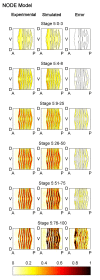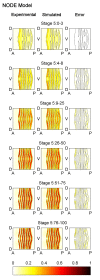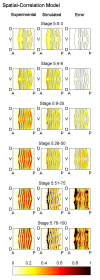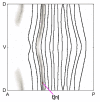Nonparametric identification of regulatory interactions from spatial and temporal gene expression data
- PMID: 20684787
- PMCID: PMC2933715
- DOI: 10.1186/1471-2105-11-413
Nonparametric identification of regulatory interactions from spatial and temporal gene expression data
Abstract
Background: The correlation between the expression levels of transcription factors and their target genes can be used to infer interactions within animal regulatory networks, but current methods are limited in their ability to make correct predictions.
Results: Here we describe a novel approach which uses nonparametric statistics to generate ordinary differential equation (ODE) models from expression data. Compared to other dynamical methods, our approach requires minimal information about the mathematical structure of the ODE; it does not use qualitative descriptions of interactions within the network; and it employs new statistics to protect against over-fitting. It generates spatio-temporal maps of factor activity, highlighting the times and spatial locations at which different regulators might affect target gene expression levels. We identify an ODE model for eve mRNA pattern formation in the Drosophila melanogaster blastoderm and show that this reproduces the experimental patterns well. Compared to a non-dynamic, spatial-correlation model, our ODE gives 59% better agreement to the experimentally measured pattern. Our model suggests that protein factors frequently have the potential to behave as both an activator and inhibitor for the same cis-regulatory module depending on the factors' concentration, and implies different modes of activation and repression.
Conclusions: Our method provides an objective quantification of the regulatory potential of transcription factors in a network, is suitable for both low- and moderate-dimensional gene expression datasets, and includes improvements over existing dynamic and static models.
Figures











Similar articles
-
A systematic analysis of the gap gene system in the moth midge Clogmia albipunctata.Dev Biol. 2010 Aug 1;344(1):306-18. doi: 10.1016/j.ydbio.2010.04.019. Epub 2010 Apr 28. Dev Biol. 2010. PMID: 20433825
-
Spatial bistability generates hunchback expression sharpness in the Drosophila embryo.PLoS Comput Biol. 2008 Sep 26;4(9):e1000184. doi: 10.1371/journal.pcbi.1000184. PLoS Comput Biol. 2008. PMID: 18818726 Free PMC article.
-
Temporal and spatial dynamics of scaling-specific features of a gene regulatory network in Drosophila.Nat Commun. 2015 Dec 8;6:10031. doi: 10.1038/ncomms10031. Nat Commun. 2015. PMID: 26644070 Free PMC article.
-
Drosophila blastoderm patterning.Curr Opin Genet Dev. 2012 Dec;22(6):533-41. doi: 10.1016/j.gde.2012.10.005. Epub 2013 Jan 4. Curr Opin Genet Dev. 2012. PMID: 23290311 Review.
-
Making models match measurements: model optimization for morphogen patterning networks.Semin Cell Dev Biol. 2014 Nov;35:109-23. doi: 10.1016/j.semcdb.2014.06.017. Epub 2014 Jul 9. Semin Cell Dev Biol. 2014. PMID: 25016297 Free PMC article. Review.
Cited by
-
Mouse IDGenes: a reference database for genetic interactions in the developing mouse brain.Database (Oxford). 2014 Aug 20;2014:bau083. doi: 10.1093/database/bau083. Print 2014. Database (Oxford). 2014. PMID: 25145340 Free PMC article.
-
Shaped singular spectrum analysis for quantifying gene expression, with application to the early Drosophila embryo.Biomed Res Int. 2015;2015:689745. doi: 10.1155/2015/689745. Epub 2015 Mar 19. Biomed Res Int. 2015. PMID: 25945341 Free PMC article.
-
Building quantitative, three-dimensional atlases of gene expression and morphology at cellular resolution.Wiley Interdiscip Rev Dev Biol. 2013 Nov-Dec;2(6):767-79. doi: 10.1002/wdev.107. Epub 2013 Feb 4. Wiley Interdiscip Rev Dev Biol. 2013. PMID: 24123936 Free PMC article. Review.
-
Reverse-engineering human regulatory networks.Wiley Interdiscip Rev Syst Biol Med. 2012 Jul-Aug;4(4):311-25. doi: 10.1002/wsbm.1159. Epub 2012 Jan 13. Wiley Interdiscip Rev Syst Biol Med. 2012. PMID: 22246697 Free PMC article. Review.
References
-
- Markowetz F, Spang R. Inferring cellular networks - a review. BMC Bioinformatics. 2007;8(Suppl 6):S5. doi: 10.1186/1471-2105-8-S6-S5. http://www.biomedcentral.com/1471-2105/8/S6/S5 - DOI - PMC - PubMed
Publication types
MeSH terms
Substances
Grants and funding
LinkOut - more resources
Full Text Sources
Molecular Biology Databases

